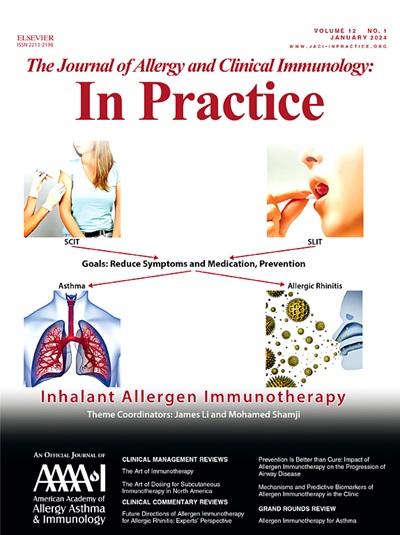Health-Related Quality of Life in Chronic Urticaria: A Systematic Review and Meta-Analysis
IF 6.6
1区 医学
Q1 ALLERGY
Journal of Allergy and Clinical Immunology-In Practice
Pub Date : 2025-09-01
DOI:10.1016/j.jaip.2025.03.049
引用次数: 0
Abstract
Background
Chronic urticaria (CU), including chronic spontaneous urticaria (CSU) and chronic inducible urticaria (CIndU), significantly affect patients’ health-related quality of life (HRQOL). To date, no systematic reviews or meta-analyses have summarized the HRQOL tools used in CU and the magnitude of HRQOL impact in CU.
Objective
To determine the HRQOL tools used in CU, the burden of CU regarding HRQOL in adults and children, and whether CU subtypes differentially affect HRQOL.
Methods
We searched MEDLINE, Embase, Web of Science, Cochrane, CINAHL, and PsycINFO from inception to August 20, 2023 for original articles including populations of adult or pediatric patients with CU or any of its subtypes in which HRQOL was reported using any quality-of-life instrument. We conducted a series of meta-analyses to pool and compare data on HRQOL outcomes by CU subtype, primarily using the Dermatology Life Quality Index.
Results
We identified 123 publications reporting on 23,508 unique patients with CU and/or its subtypes. The meta-analysis revealed a moderate to large impact of CU and its subtypes on HRQOL. In adults, pooled mean Dermatology Life Quality Index score was 8.9 (95% CI, 7.7-10.1) for CU, 11.0 (95% CI, 9.3-12.7) for CSU, 8.3 (95% CI, 6.8-9.8) for CIndU, and 10.0 (95% CI, 7.7-12.4) for concomitant CSU/CIndU. In children with CSU, mean Children Dermatology Life Quality Index score was 6.9 (95% CI, 1.9-12.0). The analysis revealed high heterogeneity, likely owing to differences in patient population and study design.
Conclusions
Chronic urticaria and its subtypes significantly impair HRQOL. The clinical implication of the differences among CU subtypes needs to be further explored, along with additional research in pediatric populations.
慢性荨麻疹患者与健康相关的生活质量:系统回顾和荟萃分析
背景:慢性荨麻疹(Chronic Urticaria, CU),包括慢性自发性荨麻疹(Chronic Spontaneous Urticaria, CSU)和慢性诱导性荨麻疹(Chronic Inducible Urticaria, CIndU),显著影响患者健康相关生活质量(HRQOL)。到目前为止,还没有系统的综述或荟萃分析总结了在CU中使用的HRQOL工具和HRQOL对CU的影响程度。目的:了解CU中使用的HRQOL工具,成人和儿童CU对HRQOL的负担,以及CU亚型对HRQOL的影响是否存在差异。方法:我们检索MEDLINE, Embase, Web of Science, Cochrane, CINAHL,和PsycINFO从成立到2023年8月20日的原始文章,包括使用任何生活质量工具报告HRQOL的成人或儿童CU患者或其任何亚型。我们进行了一系列荟萃分析,主要利用皮肤生活质量指数(DLQI)来汇总和比较不同CU亚型患者HRQOL结果的数据。结果:我们确定了123篇报道23,508例独特的CU和/或其亚型的出版物。meta分析显示CU及其亚型对HRQOL有中等到较大的影响。在成人中,合并平均DLQI评分为:CU为8.9,95%CI=7.7-10.1, CSU为11.0,95%CI=9.3-12.7, CIndU为8.3,95%CI=6.8-9.8, CSU/CIndU为10.0,95%CI=7.7-12.4。在CSU患儿中,平均CDLQI评分为6.9,95%CI=1.9-12.0。分析显示高度异质性,可能是由于患者群体和研究设计的差异。结论:CU及其亚型明显影响HRQOL。CU亚型之间差异的临床意义需要进一步探讨,并在儿科人群中进行更多的研究。
本文章由计算机程序翻译,如有差异,请以英文原文为准。
求助全文
约1分钟内获得全文
求助全文
来源期刊

Journal of Allergy and Clinical Immunology-In Practice
ALLERGYIMMUNOLOGY-IMMUNOLOGY
CiteScore
11.10
自引率
9.60%
发文量
683
审稿时长
50 days
期刊介绍:
JACI: In Practice is an official publication of the American Academy of Allergy, Asthma & Immunology (AAAAI). It is a companion title to The Journal of Allergy and Clinical Immunology, and it aims to provide timely clinical papers, case reports, and management recommendations to clinical allergists and other physicians dealing with allergic and immunologic diseases in their practice. The mission of JACI: In Practice is to offer valid and impactful information that supports evidence-based clinical decisions in the diagnosis and management of asthma, allergies, immunologic conditions, and related diseases.
This journal publishes articles on various conditions treated by allergist-immunologists, including food allergy, respiratory disorders (such as asthma, rhinitis, nasal polyps, sinusitis, cough, ABPA, and hypersensitivity pneumonitis), drug allergy, insect sting allergy, anaphylaxis, dermatologic disorders (such as atopic dermatitis, contact dermatitis, urticaria, angioedema, and HAE), immunodeficiency, autoinflammatory syndromes, eosinophilic disorders, and mast cell disorders.
The focus of the journal is on providing cutting-edge clinical information that practitioners can use in their everyday practice or to acquire new knowledge and skills for the benefit of their patients. However, mechanistic or translational studies without immediate or near future clinical relevance, as well as animal studies, are not within the scope of the journal.
 求助内容:
求助内容: 应助结果提醒方式:
应助结果提醒方式:


